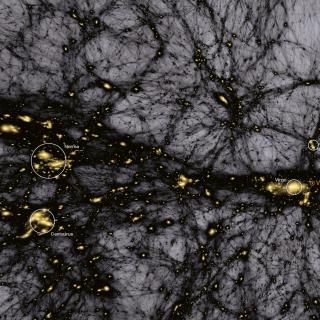Bibcode
Melia, F.; López-Corredoira, M.
Bibliographical reference
International Journal of Modern Physics D
Advertised on:
4
2022
Citations
6
Refereed citations
6
Description
The baryon acoustic oscillation (BAO) peak, seen in the cosmic matter distribution at redshifts up to ∼3.5, reflects the continued expansion of the sonic horizon first identified in temperature anisotropies of the cosmic microwave background. The BAO peak position can now be measured to better than ∼1% accuracy using galaxies and ∼1.4-1.6% precision with Ly-α forests and the clustering of quasars. In conjunction with the Alcock-Paczyński (AP) effect, which arises from the changing ratio of angular to spatial/redshift size of (presumed) spherically-symmetric source distributions with distance, the BAO measurement is viewed as one of the most powerful tools to use in assessing the geometry of the Universe. In this paper, we employ five BAO peak measurements from the final release of the Sloan Digital Sky Survey IV, at average redshifts 〈z〉 = 0.38, 0.51, 0.70, 1.48 and 2.33, to carry out a direct head-to-head comparison of the standard model, ΛCDM, and one of its principal competitors, known as the Rh = ct universe. For completeness, we complement the AP diagnostic with a volume-averaged distance probe that assumes a constant comoving distance scale rd. Both probes are free of uncertain parameters, such as the Hubble constant, and are therefore ideally suited for this kind of model selection. We find that Rh = ct is favored by these measurements over the standard model based solely on the AP effect, with a likelihood ∼75% versus ∼25%, while Planck-ΛCDM is favored over Rh = ct based solely on the volume-averaged distance probe, with a likelihood ∼80% versus ∼20%. A joint analysis using both probes produces an inconclusive outcome, yielding comparable likelihoods to both models. We are therefore not able to confirm with this work that the BAO data, on their own, support an accelerating Universe.
Related projects

Cosmology with Large Scale Structure Probes
The Cosmic Microwave Background (CMB) contains the statistical information about the early seeds of the structure formation in our Universe. Its natural counterpart in the local universe is the distribution of galaxies that arises as a result of gravitational growth of those primordial and small density fluctuations. The characterization of the
FRANCISCO SHU
KITAURA JOYANES